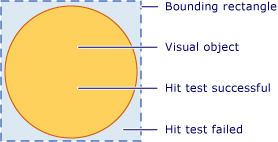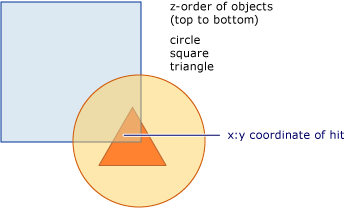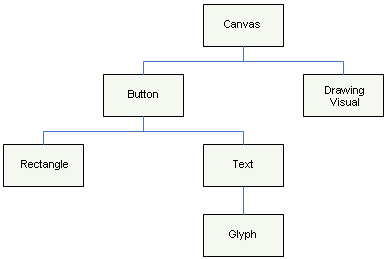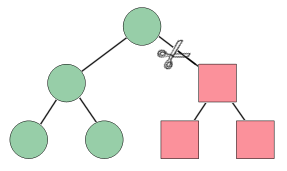Hit testing a livello visivo
In questo argomento vengono forniti dei cenni preliminari sulle funzionalità di hit testing fornite dal livello visivo. Il supporto di hit testing consente di determinare se un valore di geometria o punto rientra nel contenuto sottoposto a rendering di un Visualoggetto , consentendo di implementare il comportamento dell'interfaccia utente, ad esempio un rettangolo di selezione per selezionare più oggetti.
Scenari di hit Testing
La UIElement classe fornisce il InputHitTest metodo , che consente di eseguire il hit test su un elemento usando un determinato valore di coordinata. In molti casi, il InputHitTest metodo fornisce la funzionalità desiderata per l'implementazione di hit testing di elementi. Esistono tuttavia diversi scenari nei quali potrebbe essere necessario implementare l'hit testing a livello visivo.
Hit testing su oggetti nonUIElement : questo vale se si esegue il hit testing di oggetti nonUIElement , ad esempio DrawingVisual o oggetti grafici.
Hit testing tramite una geometria: applicabile se è necessario eseguire un hit test usando un oggetto geometry anziché il valore delle coordinate di un punto.
Hit testing su più oggetti: applicabile quando è necessario eseguire un hit test su più oggetti, ad esempio oggetti sovrapposti. È possibile ottenere risultati per tutti gli elementi visivi che intersecano una geometria o un punto, non solo il primo.
Ignorando UIElement i criteri di hit testing: questo vale quando è necessario ignorare i UIElement criteri di hit testing, che prende in considerazione fattori come se un elemento è disabilitato o invisibile.
Nota
Per un esempio di codice completo che illustra l'hit testing a livello visivo, vedere Hit Test Using DrawingVisuals Sample (Esempio di Hit Test mediante DrawingVisual) e Hit Test with Win32 Interoperation Sample (Esempio di hit test con interoperatività Win32).
Supporto per Hit Testing
Lo scopo dei HitTest metodi nella VisualTreeHelper classe è determinare se un valore di coordinata geometry o punto si trova all'interno del contenuto sottoposto a rendering di un determinato oggetto, ad esempio un controllo o un elemento grafico. Ad esempio, è possibile usare l'hit testing per determinare se un clic del mouse all'interno del rettangolo di delimitazione di un oggetto avviene all'interno della geometria di un cerchio. È inoltre possibile scegliere di eseguire l'override dell'implementazione predefinita dell'hit testing per eseguire calcoli di hit testing personalizzati.
La figura seguente mostra la relazione tra l'area dell'oggetto non rettangolare e il rettangolo di delimitazione.

Diagramma dell'area di hit testing valida
Hit Testing e ordine Z
Il livello visivo Windows Presentation Foundation (WPF) supporta il hit testing su tutti gli oggetti in un punto o in una geometria, non solo l'oggetto più in alto. I risultati vengono restituiti nell'ordine Z. Tuttavia, l'oggetto visivo passato come parametro al HitTest metodo determina quale parte della struttura ad albero visuale che verrà superata. È possibile sottoporre a hit testing l'intera struttura ad albero visuale o parte di essa.
Nella figura seguente, l'oggetto cerchio è sovrapposto sia al quadrato che al triangolo. Se si è interessati solo all'hit testing dell'oggetto visivo il cui valore dell'ordine z è il massimo, è possibile impostare l'enumerazione dell'hit test visivo da restituire Stop da HitTestResultCallback per arrestare l'attraversamento dell'hit test dopo il primo elemento.

Diagramma dell'ordine Z di una struttura ad albero visuale
Se si desidera enumerare tutti gli oggetti visivi in un punto o una geometria specifica, restituire Continue da HitTestResultCallback. Ciò significa che è possibile eseguire l'hit test per gli oggetti visivi che sono al di sotto di altri oggetti, anche se sono completamente nascosti. Per altre informazioni, vedere il codice di esempio nella sezione "Utilizzo del callback dei risultati di un hit test".
Nota
Anche un oggetto visivo trasparente può essere sottoposto a hit test.
Uso dell'hit testing predefinito
È possibile identificare se un punto si trova all'interno della geometria di un oggetto visivo utilizzando il HitTest metodo per specificare un oggetto visivo e un valore di coordinata punto su cui eseguire il test. Il parametro dell'oggetto visivo identifica il punto di avvio nella struttura ad albero visuale della ricerca dell'hit test. Se un oggetto visivo viene trovato nella struttura ad albero visuale la cui geometria contiene la coordinata, viene impostata sulla VisualHit proprietà di un HitTestResult oggetto . Viene HitTestResult quindi restituito dal HitTest metodo . Se il punto non è contenuto nell'albero secondario visivo di cui si esegue il hit testing, HitTest restituisce null.
Nota
L'hit testing predefinito restituisce sempre l'oggetto di livello superiore nell'ordine Z. Per identificare tutti gli oggetti visivi, compresi quelli che potrebbero essere parzialmente o completamente nascosti, usare un callback dei risultati dell'hit test.
Il valore della coordinata passato come parametro punto per il HitTest metodo deve essere relativo allo spazio delle coordinate dell'oggetto visivo su cui si esegue il hit testing. Ad esempio, se sono presenti oggetti visivi annidati nelle coordinate (100, 100) nello spazio delle coordinate dell'elemento padre, l'hit testing su un oggetto visivo figlio con coordinate (0, 0) è equivalente all'hit testing con coordinate (100, 100) nello spazio delle coordinate dell'elemento padre.
Nel codice seguente viene illustrato come configurare i gestori eventi del mouse per un UIElement oggetto usato per acquisire gli eventi usati per l'hit testing.
// Respond to the left mouse button down event by initiating the hit test.
private void OnMouseLeftButtonDown(object sender, MouseButtonEventArgs e)
{
// Retrieve the coordinate of the mouse position.
Point pt = e.GetPosition((UIElement)sender);
// Perform the hit test against a given portion of the visual object tree.
HitTestResult result = VisualTreeHelper.HitTest(myCanvas, pt);
if (result != null)
{
// Perform action on hit visual object.
}
}
' Respond to the left mouse button down event by initiating the hit test.
Private Overloads Sub OnMouseLeftButtonDown(ByVal sender As Object, ByVal e As MouseButtonEventArgs)
' Retrieve the coordinate of the mouse position.
Dim pt As Point = e.GetPosition(CType(sender, UIElement))
' Perform the hit test against a given portion of the visual object tree.
Dim result As HitTestResult = VisualTreeHelper.HitTest(myCanvas, pt)
If result IsNot Nothing Then
' Perform action on hit visual object.
End If
End Sub
Effetti della struttura ad albero visuale sull'hit testing
Il punto iniziale nella struttura ad albero visuale determina quali oggetti vengono restituiti durante l'enumerazione di hit test degli oggetti. Se si dispone di più oggetti da sottoporre a hit test, l'oggetto visivo usato come punto di inizio nella struttura ad albero visuale deve essere il predecessore comune di tutti gli oggetti interessati. Se si desidera ad esempio sottoporre a hit test sia l'elemento pulsante che l'elemento visivo di disegno nel diagramma seguente, è necessario impostare il punto di inizio nella struttura ad albero visuale sul predecessore comune a entrambi. In questo caso, l'elemento canvas è il predecessore comune di sia dell'elemento pulsante che dell'elemento visivo di disegno.

Diagramma della gerarchia di una struttura ad albero visuale
Nota
La IsHitTestVisible proprietà ottiene o imposta un valore che dichiara se un UIElementoggetto derivato da -può essere restituito come risultato di hit test da una parte del relativo contenuto sottoposto a rendering. In questo modo è possibile modificare selettivamente la struttura ad albero visuale per determinare quali oggetti visivi sono coinvolti in un hit test.
Uso del callback dei risultati di un hit test
È possibile enumerare tutti gli oggetti visivi in una struttura ad albero visuale la cui geometria contiene un valore di coordinate specificato. Ciò consente di identificare tutti gli oggetti visivi, inclusi quelli che potrebbero essere parzialmente o completamente nascosti da altri oggetti visivi. Per enumerare gli oggetti visivi in una struttura ad albero visuale, usare il HitTest metodo con una funzione di callback di hit test. La funzione di callback dell'hit test viene chiamata dal sistema quando il valore delle coordinate specificato è contenuto in un oggetto visivo.
Durante l'enumerazione dei risultati dell'hit test, evitare di eseguire operazioni che modifichino la struttura ad albero visuale. L'aggiunta o la rimozione di un oggetto dalla struttura ad albero visuale mentre viene attraversata può produrre un comportamento imprevedibile. È possibile modificare in modo sicuro la struttura ad albero visuale dopo la restituzione del HitTest metodo. È possibile specificare una struttura di dati, ad esempio un ArrayListoggetto , per archiviare i valori durante l'enumerazione dei risultati dell'hit test.
// Respond to the right mouse button down event by setting up a hit test results callback.
private void OnMouseRightButtonDown(object sender, MouseButtonEventArgs e)
{
// Retrieve the coordinate of the mouse position.
Point pt = e.GetPosition((UIElement)sender);
// Clear the contents of the list used for hit test results.
hitResultsList.Clear();
// Set up a callback to receive the hit test result enumeration.
VisualTreeHelper.HitTest(myCanvas, null,
new HitTestResultCallback(MyHitTestResult),
new PointHitTestParameters(pt));
// Perform actions on the hit test results list.
if (hitResultsList.Count > 0)
{
Console.WriteLine("Number of Visuals Hit: " + hitResultsList.Count);
}
}
' Respond to the right mouse button down event by setting up a hit test results callback.
Private Overloads Sub OnMouseRightButtonDown(ByVal sender As Object, ByVal e As MouseButtonEventArgs)
' Retrieve the coordinate of the mouse position.
Dim pt As Point = e.GetPosition(CType(sender, UIElement))
' Clear the contents of the list used for hit test results.
hitResultsList.Clear()
' Set up a callback to receive the hit test result enumeration.
VisualTreeHelper.HitTest(myCanvas, Nothing, New HitTestResultCallback(AddressOf MyHitTestResult), New PointHitTestParameters(pt))
' Perform actions on the hit test results list.
If hitResultsList.Count > 0 Then
Console.WriteLine("Number of Visuals Hit: " & hitResultsList.Count)
End If
End Sub
Il metodo di callback dell'hit test definisce le azioni eseguite quando viene identificato un hit test su un determinato oggetto visivo nella struttura ad albero visuale. Dopo aver eseguito le azioni, viene restituito un HitTestResultBehavior valore che determina se continuare o meno l'enumerazione di qualsiasi altro oggetto visivo.
// Return the result of the hit test to the callback.
public HitTestResultBehavior MyHitTestResult(HitTestResult result)
{
// Add the hit test result to the list that will be processed after the enumeration.
hitResultsList.Add(result.VisualHit);
// Set the behavior to return visuals at all z-order levels.
return HitTestResultBehavior.Continue;
}
' Return the result of the hit test to the callback.
Public Function MyHitTestResult(ByVal result As HitTestResult) As HitTestResultBehavior
' Add the hit test result to the list that will be processed after the enumeration.
hitResultsList.Add(result.VisualHit)
' Set the behavior to return visuals at all z-order levels.
Return HitTestResultBehavior.Continue
End Function
Nota
L'ordine di enumerazione di oggetti visivi di hit testing è l'ordine Z. L'oggetto visivo di livello superiore nell'ordine Z viene enumerato per primo. Gli altri oggetti visivi vengono enumerati a livelli decrescenti nell'ordine Z. Questo ordine di enumerazione corrisponde all'ordine di rendering degli oggetti visivi.
È possibile arrestare l'enumerazione degli oggetti visivi in qualsiasi momento nella funzione di callback di hit test restituendo Stop.
// Set the behavior to stop enumerating visuals.
return HitTestResultBehavior.Stop;
' Set the behavior to stop enumerating visuals.
Return HitTestResultBehavior.Stop
Uso del callback di un filtro dell'hit test
È possibile usare un filtro dell'hit test facoltativo per limitare gli oggetti inviati ai risultati dell'hit test. Ciò consente di ignorare parti della struttura ad albero visuale che non si desidera elaborare nei risultati dell'hit test. Per implementare un filtro hit test, definire una funzione di callback del filtro hit test e passarla come valore di parametro quando si chiama il HitTest metodo .
// Respond to the mouse wheel event by setting up a hit test filter and results enumeration.
private void OnMouseWheel(object sender, MouseWheelEventArgs e)
{
// Retrieve the coordinate of the mouse position.
Point pt = e.GetPosition((UIElement)sender);
// Clear the contents of the list used for hit test results.
hitResultsList.Clear();
// Set up a callback to receive the hit test result enumeration.
VisualTreeHelper.HitTest(myCanvas,
new HitTestFilterCallback(MyHitTestFilter),
new HitTestResultCallback(MyHitTestResult),
new PointHitTestParameters(pt));
// Perform actions on the hit test results list.
if (hitResultsList.Count > 0)
{
ProcessHitTestResultsList();
}
}
' Respond to the mouse wheel event by setting up a hit test filter and results enumeration.
Private Overloads Sub OnMouseWheel(ByVal sender As Object, ByVal e As MouseWheelEventArgs)
' Retrieve the coordinate of the mouse position.
Dim pt As Point = e.GetPosition(CType(sender, UIElement))
' Clear the contents of the list used for hit test results.
hitResultsList.Clear()
' Set up a callback to receive the hit test result enumeration.
VisualTreeHelper.HitTest(myCanvas, New HitTestFilterCallback(AddressOf MyHitTestFilter), New HitTestResultCallback(AddressOf MyHitTestResult), New PointHitTestParameters(pt))
' Perform actions on the hit test results list.
If hitResultsList.Count > 0 Then
ProcessHitTestResultsList()
End If
End Sub
Se non si vuole specificare la funzione di callback del filtro hit test facoltativa, passare un null valore come parametro per il HitTest metodo .
// Set up a callback to receive the hit test result enumeration,
// but no hit test filter enumeration.
VisualTreeHelper.HitTest(myCanvas,
null, // No hit test filtering.
new HitTestResultCallback(MyHitTestResult),
new PointHitTestParameters(pt));
' Set up a callback to receive the hit test result enumeration,
' but no hit test filter enumeration.
VisualTreeHelper.HitTest(myCanvas, Nothing, New HitTestResultCallback(AddressOf MyHitTestResult), New PointHitTestParameters(pt)) ' No hit test filtering.

Eliminazione di una struttura ad albero visuale
La funzione di callback del filtro dell'hit test consente di enumerare tutti gli oggetti visivi il cui contenuto di rendering include le coordinate specificate. È possibile tuttavia decidere di ignorare determinate parti della struttura ad albero visuale che non si desidera elaborare nella funzione di callback dei risultati dell'hit test. Il valore restituito dalla funzione di callback del filtro dell'hit test determina il tipo di azione che deve essere eseguita dall'enumerazione degli oggetti visivi. Ad esempio, se si restituisce il valore , ContinueSkipSelfAndChildrenè possibile rimuovere l'oggetto visivo corrente e i relativi elementi figlio dall'enumerazione dei risultati dell'hit test. Ciò significa che la funzione di callback dei risultati di hit test non visualizzerà questi oggetti nell'enumerazione. L'eliminazione di oggetti dalla struttura ad albero visuale consente di ridurre la quantità di elaborazione durante la fase di enumerazione dei risultati dell'hit test. Nell'esempio di codice seguente il filtro ignora le etichette e i relativi discendenti e sottopone a hit test tutti gli altri elementi.
// Filter the hit test values for each object in the enumeration.
public HitTestFilterBehavior MyHitTestFilter(DependencyObject o)
{
// Test for the object value you want to filter.
if (o.GetType() == typeof(Label))
{
// Visual object and descendants are NOT part of hit test results enumeration.
return HitTestFilterBehavior.ContinueSkipSelfAndChildren;
}
else
{
// Visual object is part of hit test results enumeration.
return HitTestFilterBehavior.Continue;
}
}
' Filter the hit test values for each object in the enumeration.
Public Function MyHitTestFilter(ByVal o As DependencyObject) As HitTestFilterBehavior
' Test for the object value you want to filter.
If o.GetType() Is GetType(Label) Then
' Visual object and descendants are NOT part of hit test results enumeration.
Return HitTestFilterBehavior.ContinueSkipSelfAndChildren
Else
' Visual object is part of hit test results enumeration.
Return HitTestFilterBehavior.Continue
End If
End Function
Nota
Verrà talvolta chiamato il callback del filtro dell'hit test nei casi in cui non viene chiamato il callback di risultati dell'hit test.
Override dell'hit testing predefinito
È possibile eseguire l'override del supporto di hit testing predefinito di un oggetto visivo eseguendo l'override del HitTestCore metodo . Ciò significa che quando si richiama il HitTest metodo , viene chiamata l'implementazione sottoposta a override di HitTestCore . Il metodo sottoposto a override viene chiamato quando un hit test viene eseguito all'interno del rettangolo delimitatore dell'oggetto visivo, anche se le coordinate non rientrano nel contenuto sottoposto a rendering dell'oggetto visivo.
// Override default hit test support in visual object.
protected override HitTestResult HitTestCore(PointHitTestParameters hitTestParameters)
{
Point pt = hitTestParameters.HitPoint;
// Perform custom actions during the hit test processing,
// which may include verifying that the point actually
// falls within the rendered content of the visual.
// Return hit on bounding rectangle of visual object.
return new PointHitTestResult(this, pt);
}
' Override default hit test support in visual object.
Protected Overrides Overloads Function HitTestCore(ByVal hitTestParameters As PointHitTestParameters) As HitTestResult
Dim pt As Point = hitTestParameters.HitPoint
' Perform custom actions during the hit test processing,
' which may include verifying that the point actually
' falls within the rendered content of the visual.
' Return hit on bounding rectangle of visual object.
Return New PointHitTestResult(Me, pt)
End Function
È possibile che si desideri eseguire un hit test sia sul rettangolo di delimitazione, sia sul contenuto di rendering di un oggetto visivo. Usando il valore del PointHitTestParameters parametro nel metodo sottoposto HitTestCore a override come parametro del metodo HitTestCoredi base , è possibile eseguire azioni in base a un hit del rettangolo di delimitazione di un oggetto visivo e quindi eseguire un secondo hit test sul contenuto sottoposto a rendering dell'oggetto visivo.
// Override default hit test support in visual object.
protected override HitTestResult HitTestCore(PointHitTestParameters hitTestParameters)
{
// Perform actions based on hit test of bounding rectangle.
// ...
// Return results of base class hit testing,
// which only returns hit on the geometry of visual objects.
return base.HitTestCore(hitTestParameters);
}
' Override default hit test support in visual object.
Protected Overrides Overloads Function HitTestCore(ByVal hitTestParameters As PointHitTestParameters) As HitTestResult
' Perform actions based on hit test of bounding rectangle.
' ...
' Return results of base class hit testing,
' which only returns hit on the geometry of visual objects.
Return MyBase.HitTestCore(hitTestParameters)
End Function
Vedi anche
- HitTest
- HitTestResult
- HitTestResultCallback
- HitTestFilterCallback
- IsHitTestVisible
- Hit Test Using DrawingVisuals Sample (Esempio di Hit Test mediante DrawingVisual)
- Hit Test with Win32 Interoperation Sample (Esempio di hit test con interoperatività Win32)
- Eseguire un hit test della geometria in un oggetto Visual
- Eseguire un hit test utilizzando un contenitore di host Win32
.NET Desktop feedback
Commenti e suggerimenti
Presto disponibile: Nel corso del 2024 verranno gradualmente disattivati i problemi di GitHub come meccanismo di feedback per il contenuto e ciò verrà sostituito con un nuovo sistema di feedback. Per altre informazioni, vedere https://aka.ms/ContentUserFeedback.
Invia e visualizza il feedback per
